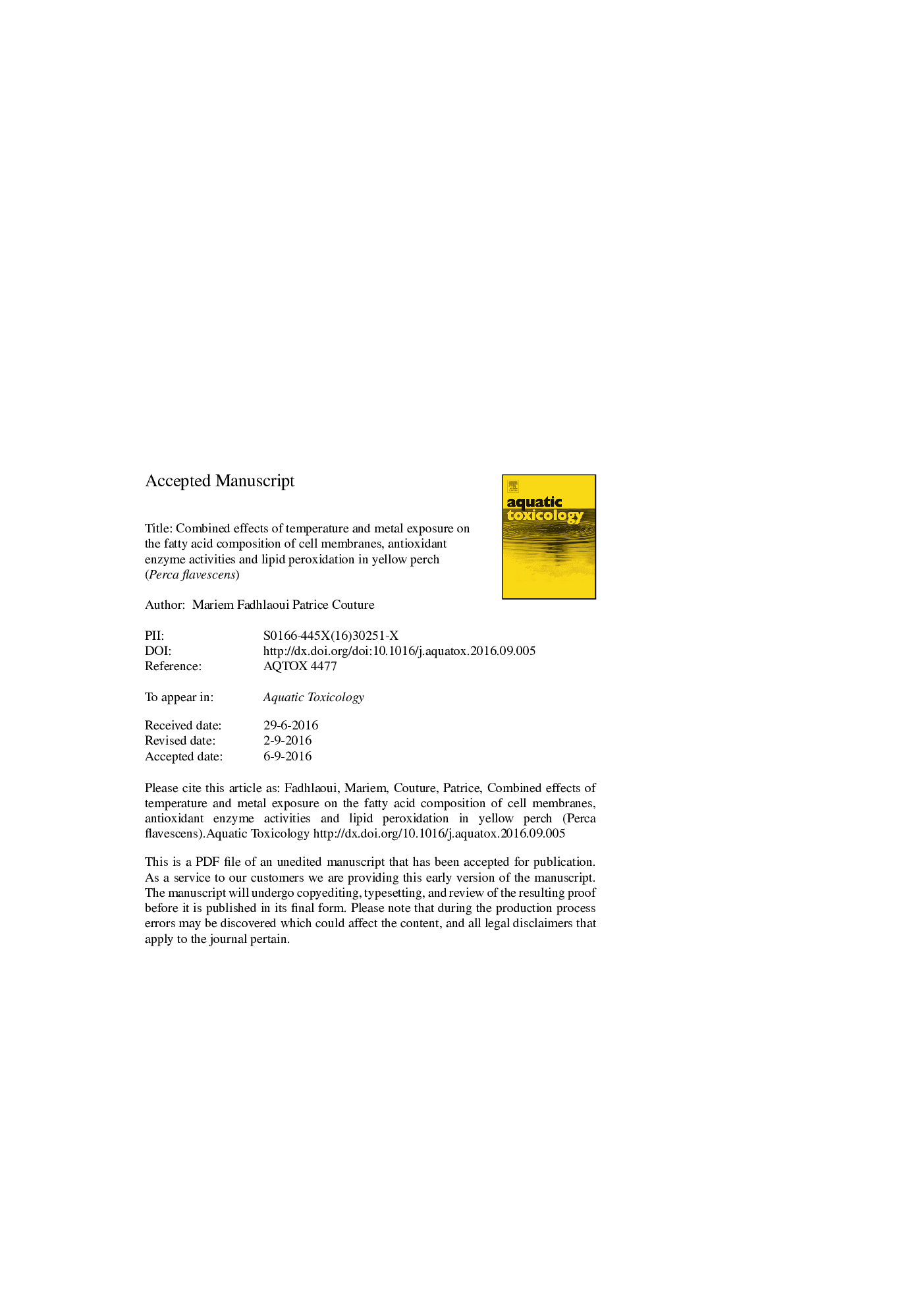| کد مقاله | کد نشریه | سال انتشار | مقاله انگلیسی | نسخه تمام متن |
|---|---|---|---|---|
| 6381807 | 1625925 | 2016 | 41 صفحه PDF | دانلود رایگان |
عنوان انگلیسی مقاله ISI
Combined effects of temperature and metal exposure on the fatty acid composition of cell membranes, antioxidant enzyme activities and lipid peroxidation in yellow perch (Perca flavescens)
دانلود مقاله + سفارش ترجمه
دانلود مقاله ISI انگلیسی
رایگان برای ایرانیان
کلمات کلیدی
GSTSFAMUFAD5DD6DHSILPOGPXGSHn-6 PUFACATELOVL2Δ5-desaturaseΔ6-desaturaseMDAStearoyl-CoA-desaturaseEPAn-3 PUFA - N-3 PUFAAntioxidant enzymes - آنزیم های آنتی اکسیدانPolyunsaturated fatty acids - اسید چرب اشباع نشدهPUFA - اسید چرب چند غیراشباعsaturated fatty acids - اسیدهای چرب اشباع شدهmonounsaturated fatty acids - اسیدهای چرب غیر اشباعphospholipid fatty acids - اسیدهای چرب فسفولیپیدARA - در حال حاضرTemperature - دماDHA - دوکوساهگزائنوئیک اسیدSOD - سدSuperoxide dismutase - سوکسوکس دیسموتازHepatosomatic index - شاخص HepatosomaticCondition index - شاخص وضعیتcell membranes - غشای سلولیmalondialdehyde - مالون دی آلدهیدFish - ماهیNickel - نیکلLipid peroxidation - پراکسیداسیون لیپیدCatalase - کاتالازCadmium - کادمیمreduced glutathione - کاهش گلوتاتیونglutathione-S-transferase - گلوتاتیون S-ترانسفرازglutathione peroxidase - گلوتاتیون پراکسیداز
موضوعات مرتبط
علوم زیستی و بیوفناوری
علوم کشاورزی و بیولوژیک
علوم آبزیان
پیش نمایش صفحه اول مقاله

چکیده انگلیسی
The aim of this study was to investigate the combined effects of temperature and metal contamination (cadmium and nickel) on phospholipid fatty acid composition, antioxidant enzyme activities and lipid peroxidation in fish. Yellow perch were acclimated to two different temperatures (9 °C and 28 °C) and exposed either to Cd or Ni (respectively 4 μg/L and 600 μg/L) for seven weeks. Superoxide dismutase, catalase, glutathione-S-transferase, glutathione peroxidase activities and glutathione concentration were measured as indicators of antioxidant capacities, while malondialdehyde concentration was used as an indicator of lipid peroxidation. Poikilotherms including fish counteract the effects of temperature on phospholipid fatty acid ordering by remodelling their composition to maintain optimal fluidity. Accordingly, in our study, the fatty acid composition of yellow perch muscle at 9 °C was enhanced in monounsaturated (MUFA) and polyunsaturated fatty acids (PUFA) compared to fish maintained at 28 °C, in agreement with the theory of homeoviscous adaptation. Using ratios of various fatty acids as surrogates for desaturase and elongase activities, our data suggests that modification of the activity of these enzymes is responsible for the thermal acclimation of phospholipid fatty acid profiles. However, this response was altered under Ni and Cd exposure: PUFA decreased (specifically n-6 PUFA) while the proportion of saturated fatty acids increased at 9 °C, whereas at 28 °C, PUFA increased to proportions exceeding those observed at 9 °C. Lipid peroxidation could be observed under all experimental conditions. Both enzymatic and non-enzymatic antioxidant defense systems acted cooperatively to cope with oxidative stress leading to lipid peroxidation, which was not affected by temperature acclimation as indicated by malondialdehyde concentration, in spite of a higher polyinsaturation in cold-acclimated fish which would be predicted to increase their vulnerability to peroxidation. However, in warm-acclimated, Ni-exposed fish, in which the highest proportion of PUFA was observed, lower concentrations of malondialdehyde were measured, suggesting an overcompensation of antioxidant mechanisms in these fish which could represent a substantial metabolic cost and explain their lower condition.
ناشر
Database: Elsevier - ScienceDirect (ساینس دایرکت)
Journal: Aquatic Toxicology - Volume 180, November 2016, Pages 45-55
Journal: Aquatic Toxicology - Volume 180, November 2016, Pages 45-55
نویسندگان
Mariem Fadhlaoui, Patrice Couture,